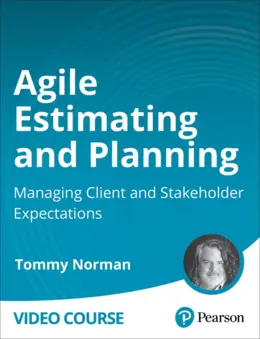Agile Estimating and Planning: Managing Client and Stakeholder Expectations (Video Course)

Agile Estimating and Planning: Managing Client and Stakeholder Expectations (Video Course)
English | MP4 | AVC 1280×720 | AAC 44KHz 2ch | 6h 41m | 1.51 GB
Agile Estimating and Planning: Managing Client and Stakeholder Expectations (Video Course): Leverage the power of Agile estimating and planning to manage client and stakeholder expectations throughout every stage of software development.
The inevitable questions while navigating a software development project with a customer are “When will it be done?” and “How much will it cost?” In this Agile Estimating and Planning: Managing Client and Stakeholder Expectations (Video Course), Agile expert Tommy Norman shows you how to manage these client and stakeholder expectations using Agile estimating and planning. You will learn how to move beyond the limitations of the time-money-scope iron triangle and address your customer’s concerns by understanding their overarching business goals.
You will learn how to scope and estimate for a software project with minimal information, as well as how to use product visioning, personas/goals, and story mapping to ensure everyone understands the why, who, and what of the product they are building. You will explore strategies to maximize the Product Backlog’s value and how to continually integrate new insights. You will discover how the Product Backlog influences the Release Plan and how it can surface early indicators that reveal the need for potential adjustments to scope and schedule. Finally, you will learn to assess the impact of deliverables on business outcomes and how to incorporate these lessons back into the Product Backlog.
Learn How To:
- Align with stakeholders’ business goals using product visioning activities.
- Give enough upfront forecasting to make sound budgeting decisions using a simple estimation process.
- Use personas and story mapping to focus on end-user value delivered.
- Apply empirical data to a simple and highly reliable release plan approach to help customers maximize value and learning.
- Use operational style review points to get ahead of any issues and keep the team and stakeholders in constant alignment.
Lesson 1: This lesson explores the underlying needs behind the questions When? and How Much? and the best way to meet these needs. It covers how to manage expectations and the importance of a successful beginning to any software development effort.
Lesson 2: This lesson covers how to set initial expectations with subsequent efforts in mind. It discusses how to identify the true business value of a software development project, how to estimate time and cost with enough accuracy to support solid decision making, and how to assess the feasibility of a software development effort.
Lesson 3: This lesson covers getting a software development effort started. It focuses on the why and how of solving end users’ problems and demonstrates populating the initial product backlog.
Lesson 4: This lesson covers how to approach estimating for a software development effort. It explores the benefits of focusing more on conversations and less on estimates to best develop a sense of time and scope for a project.
Lesson 5: This lesson covers the art of release planning. Using the product backlog and estimates worked out in the previous lessons, it demonstrates how to create a release plan that makes time, money, and value obvious to your stakeholders and your team.
Lesson 6: This lesson covers how to leverage empirical data for an agile approach to release planning. It discusses the importance of good metrics, and how such metrics can inform modifications to the release plan and allow us to adjust expectations appropriately.
Lesson 7: This lesson underscores that estimating and planning is all about expectation management. It shows how to use tools and techniques taught in preceding lessons to create short feedback loops. Tommy shares his favorite ways of reviewing progress and new information, and illustrating how the teams efforts are helping stakeholders achieve the right outcomes.
Lesson 8: This lesson covers how to successfully implement agile estimating and planning using applicable real-world examples and discusses how to scale these principles and practices.
